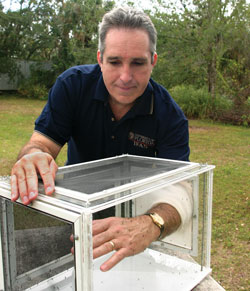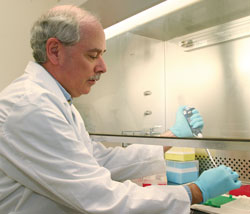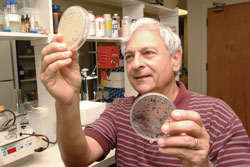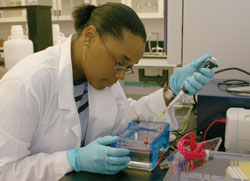|
|
By Joseph Kays Hurricane Andrew.
|
 |
|---|
Principal investigator Cynthia Lord, an associate professor of entomology, says she plugs in data from field and laboratory scientists to develop predictive mathematical models.
“We put together a model of the system as best we understand it and ask what is it doing, what does it look like?” Lord says. “We have a lot of uncertainty in our understanding of the system and that affects our ability to understand the risk.”
Each new piece of information from the laboratory and field scientists helps to fine-tune the model and reduce the uncertainty, she says.
Ultimately, Tabachnick says, the goal is to be able to predict where the “big event” might occur.
While Florida has had its share of small events in recent years, including 202 cases of West Nile Virus since 2001, Tabachnick says the right conditions could result in a much more serious situation.
“With our subtropical climate, this is fertile ground,” he says. “If you can have 200 cases of West Nile Virus in Fort Collins, Col., 10,000 cases is not beyond the imagination in Florida. That would be an absolute catastrophe. I do not think our health-care infrastructure could handle that.”
Epic Wetting
While most people are recovering from their New Year’s revelry, entomologist Jonathan Day is already preparing for Florida’s inevitable summer outbreaks of mosquito-borne diseases.
“Starting on January 1 of each year, we try to track all of the physical and biological factors that have to come in line to get a major epidemic,” says Day. “These are summer viruses — transmission peaks in August and September in Florida — but a lot of things have to happen earlier in the year to cause an epidemic.”
Day and his colleagues use a variety of techniques to track the three biological factors — mosquitoes, birds and viruses — and the physical factors, rain and temperature.
 |
|---|
Jonathan Day evaluates the effectiveness of various insect repellents against mosquitoes.
|
“Drought forces birds and mosquitoes into ever-smaller areas where there’s fresh water,” Day says. “Birds need fresh water and mosquitoes need fresh water, so amplification can really occur efficiently during these dry periods.”
By comparing past virus outbreaks with rainfall and temperature data at the time, Day has been able to deduce a rainfall “signature” that spells bad news. Day uses water table maps from the U.S. Forest Service to carefully chart what parts of Florida are getting rain.
If it stays dry, these hot spots remain isolated, but any part of Florida that gets what Day calls an “epic wetting event” — 3-plus inches of rain in a three-day period — followed by a second drydown, is ripe for trouble, because the rain allows the infected birds and mosquitoes to spread out, then the drydown forces them back together, and the virus amplifies again.
“The critical period for mosquito control would be that second dry down. At that point, the infected mosquitoes are still focused in discreet, well-known habitats. If we increase mortality with pesticides, we will decrease the number of mosquitoes that come out in that second wetting,” Day says. “Once you get that second wetting event, there’s no controlling it. That’s when you have to control people by shutting down nighttime activities.”
That’s what happened in 1991 when Disney World parades and Friday night football games were cancelled after 226 people contracted St. Louis Encephalitis.
Day admits that studying mosquitoes is a tedious, labor-intensive process.
“We’re caught in this humongous natural experiment. We have no way to control the variables in this experiment. All we can do is watch it and react to it.”
To determine the all-important infection rate, researchers vacuum up thousands of mosquitoes from suspected hot spots, separate out the disease-carrying species like Culex nigripalpus into groups of 50, grind them up in a blender and perform DNA tests on the resulting soup for evidence of West Nile Virus.
“We’re looking for an infection rate of 1 in 1,000 or less,” Day says. “Anything more than that we’re not too worried about because all the major epidemics have been less than 1 in 1,000.”
Chickens are an important component of Florida’s mosquito defense system. Each week during mosquito season, technicians at FMEL and a state Department of Health lab in Tampa perform blood tests on hundreds of “sentinel chickens” that roost near mosquito-friendly areas like swamps and retention ponds around the state.
Although West Nile Virus and St. Louis Encephalitis don’t harm chickens, the birds do produce an antibody to fight the virus. So if that antibody shows up in the blood test, researchers know the virus is present.
“The sentinels are kept in a known location, so if they turn up positive for the antibody, we can pinpoint the virus,” Day says.
Asian Tigers
As if Florida didn't have enough natural mosquito habitat, Tabachnick says the nutrient-rich retention ponds and stormwater systems mandated for new developments are perfect breeding grounds for even more mosquitoes.
 |
|---|
Walter Tabachnick extracts DNA genetic material from mosquitoes. |
"There are a lot of plans to move water all over this state," the FMEL director says. "Without attention to the impact on mosquitoes, it could backfire in some places. Properly managed, there's no reason why retention ponds and other stormwater systems should produce mosquitoes. But improperly managed, they could be a problem."
Entomologist George O'Meara spends much of his time dipping a long-handled net into stormwater catch basins around the state, trying to understand what types of mosquito larvae thrive there and why.
"Stormwater retention areas are being incorporated into all new commercial and residential developments," O'Meara says. "We are trying to find ways in which mosquito control considerations can be incorporated into the design, construction and operation of these systems."
Among O'Meara's findings are that there will be significantly fewer mosquitoes in catch basins that connect to ponds or other bodies of water because fish will eat the larvae. Occasional floods of saltwater into coastal stormwater systems will also kill larvae.
"Mosquito control would be much more cost effective if we could develop a diagnostic system that would allow the agencies to ignore 60 percent of the basins because nature is controlling the mosquitoes there," says O'Meara, a former president of the Florida Mosquito Control Association. "Ninety percent of the problem is probably in 10 percent of the basins."
O'Meara is also collaborating with colleague Phil Lounibos in an effort to better understand the role of the Asian Tiger mosquito (Aedes albopictus), which was first discovered in Florida at a scrap tire dump in Jacksonville in 1986. This mosquito -- which is now one of the state's most prevalent biting pests -- has been implicated in the transmission of dengue fever, a disease that is endemic in South America and could pose a significant threat to Florida.
"There is very real risk that dengue could enter the U.S. through Florida," Lounibos says. "We must know more about the mosquitoes capable of transmitting dengue if we hope to reduce its impact."
In addition, he says, the Asian Tiger mosquito is a good model for studying invasive mosquito species in general.
"We hope that the work we're doing on the tiger will present some paradigms and some guidance on other species. Understanding why certain mosquito species make excellent invaders is critical for protecting the United States from new pests."
The project is supported by a $2 million NIH grant to Lounibos and includes researchers at Illinois State University, Yale University and the Oswaldo Cruz Institute in Brazil.
Through his surveys of mosquito breeding sites, O'Meara has found that the Asian Tiger mosquito has actually forced the common Aedes aegypti, or yellow fever, mosquito out of its native habitats in many parts of Florida. He also found that a new mosquito (Culex biscaynensis) in South Florida occupies habitats that Asian Tiger mosquitoes would normally colonize.
"We work a lot on predators. Competition can present useful results," says Lounibos. "A non-pathogen mosquito that is a good larval competitor might represent the lesser of two evils."
Crustacean Crusher
Another way of controlling mosquitoes is introducing natural predators. That's what entomologist Jorge Rey is doing with a small crustacean called a copepod that feeds on mosquito larvae.
"By adding copepods to the water, we can kill mosquito larvae before they become adults that may spread West Nile and other diseases," Rey says. Tests at FMEL show that the copepods feed on mosquito larvae at an amazing rate, killing up to 90 percent of the larvae.
Because the copepods are common worldwide they would not be considered an exotic species. Large numbers of copepods can be grown in small plastic pools, plastic garbage cans, and similar inexpensive containers. They can be kept in water in a refrigerator for months, they can survive in soil and detritus that is only slightly damp and they are not harmed by pesticides commonly used for mosquito control.
"Over the years, a variety of other biological control agents ranging from viruses to fish have been tried for mosquito control, but nothing seems to work as effectively as this microscopic natural predator," Rey says.
Current restrictions on pesticides, along with the growing problem of insect resistance to many chemicals, make biocontrols such as the copepod increasingly attractive, Rey said.
Tabachnick says the interdisciplinary nature of FMEL dovetails perfectly with the goals of UF's Emerging Pathogens Initiative.
"The uniqueness of this center," he says, "is that when you're sitting around the table talking about the disease cycle, and trying to get at this big elephant, you've got people who see the elephant from completely different perspectives."
Day adds that the expertise does not need to be confined to looking at "elephants."
"All emerging pathogens are not going to be vector borne, but the vector-borne specialists can make important contributions to the general conversation," he says. "We specialize in pathogens that have avian amplification hosts. The knowledge we've gained about birds in Florida may become critically important to fighting avian influenza if it gets to Florida."
Day cites West Nile Virus as a sobering example of how quickly a pathogen can be introduced into a new habitat. It had never been reported in North America before 1999 and now has been reported all across the country.
"The really scary thing we've learned from West Nile is how efficiently and quickly a new pathogen can be incorporated into the ecology of North America," he says. "And there are other pathogens that can do the same thing with much more impact on human health."
Other FMEL Research
Dov Borovsky
 |
|---|
Entomology Professor Dov Borovsky has developed a mosquito “diet pill” that alters their digestion, making it impossible for them to feed, lay eggs or survive.
Borovsky discovered that the TMOF (trypsin modulating oostatic factor) hormone can stop digestion in mosquito larvae, causing them to die of starvation. He is using biotechnology to incorporate the TMOF hormone into a variety of microorganisms that mosquitoes eat.
“The same pond scum that nourishes young mosquitoes can now deliver their death blow,” Borovsky said.
Borovsky’s team has genetically engineered the aquatic organism chlorella, found in marshes, as a means to help to control mosquito larvae that eat chlorella and algae. After eating the chlorella, the larvae cannot digest food, and they die from starvation.
He has also genetically engineered yeast to produce TMOF. The yeast can be mass-produced, dried, formulated and sprayed over large areas like other pesticides. The yeast starves the mosquito larvae to death after they eat the cells.
Chelsea T. Smartt
 |
|---|
Entomology Assistant Professor Chelsea T. Smartt uses molecular biology to study ways mosquitoes become resistant to insecticides and also how mosquitoes respond when they are infected with viruses such as West Nile virus and dengue virus.
By developing an understanding about how mosquitoes become resistant to insecticides, Smartt is helping to enable effective mosquito control with minimal insecticide use.
Smartt’s studies of how viruses affect mosquito biology provide researchers with improved ability to predict mosquito-borne epidemics, and to use molecular biology to interfere with mosquito transmission.
Chuck Woods contributed to this report.
Walter Tabachnick
Director and Professor, Florida Medical Entomology Laboratory
(772) 778-7200
wjt@ufl.edu
Jonathan Day
Professor, Department of Entomology and Nematology
(772) 778-7200
jfd@mail.ifas.ufl.edu
Cynthia Lord
Associate Professor, Department of Entomology and Nematology
(772) 778-7200
clord@ufl.edu
Phil Lounibos
Professor, Department of Entomology and Nematology
(772) 778-7200
lpl@mail.ifas.ufl.edu
George O’Meara
Professor, Department of Entomology and Nematology
(772) 778-7200
gfo@mail.ifas.ufl.edu
Jorge Rey
Professor, Department of Entomology and Nematology
(772) 778-7200
jrr@mail.ifas.ufl.edu
Related Web site:
fmel.ifas.ufl.edu